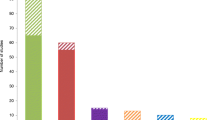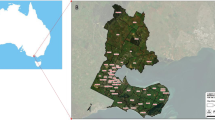Abstract
The landscape of three test areas of an urban environment was efficiently assessed for its ability to support brown rats (Rattus norvegicus Berk.) by successfully integrating habitat suitability modelling using GIS (Geographical Information System). The GIS model, validated using an independent set of rat observations, and a model analysis showed the potential of different habitats for rat occurrence. Because of its use of general land-cover types, the model could be applied to other cities. This model system will be used for the entire city area of Salzburg in the near future. In this publication, we present the results of the pilot GIS model.







Similar content being viewed by others
References
Badi MA, Iliadis N, Sarris K (1992) Natürliche und experimentelle Infektion von Nagetieren (Rattus norvegicus) mit Salmonella gallinarum. Berl Munch Tierarztl 105:264–267
Barko VA, Feldhamer GA, Nicholson MC, Davie DK (2003) Urban habitat: a determinant of white-footed mouse (Peromyscus leucopus) abundance in southern Illinois. Southeast Nat 2:369–376
Becker K (1973) Probleme der Rattenbiologie und Rattenbekämpfung. Internationales Symposium über Fragen der Rattenvertilgung in Budapest/Ungarn. In: Beihefte der Zeitschrift für angewandte Zoologie. Heft 3. Duncker & Humbolt, Berlin, pp 1–223
Channon D, Cole M, Cole L (2000) A long-term study of Rattus norvegicus in the London Borough of Enfield using baiting returns as an indicator of sewer population levels. Epidemiol Infect 125:441–445
Colvin BA, Degregorio R, Fleetwood C (1996) Norway rat infestation of urban landscaping and preventative design criteria. In: Timm RM, Crabb AC (eds) Proceedings of the 17th Vertebrate Pest Conference. University of California, Davis
Dickmann CR, Doncaster CP (1987) The ecology of small mammals in urban habitats. I. Populations in a patchy environment. J Anim Ecol 56:629–640
Endepols S (1996) Möglichkeiten der Erfassung von Vorkommen der Wanderratte (Rattus norvegicus) und der Hausratte (Rattus rattus). Schriftreihe Landsch Pfl Naturschutz 46:111–115
Engelbrecht H, Reichmuth CH (1997) Schädlinge und ihre Bekämpfung, schädlingskundlicher Gesundheits- und Vorratsschutz. Behr‘s Verlag, Hamburg, pp 1–339
Keilbach R (1966) Die tierischen Schädlinge Mitteleuropas. UEB Gustav Fischer, Jena, pp 1–784
Kobler A, Adamic M (2000) Identifying brown bear habitat by a combined GIS and machine learning method. Ecol Model 135:291–300
Krebs CJ (1989) Ecological methodology. University of British Columbia, Harper Collins Publishers, New York, pp 1–655
Langton SD, Cowan DP, Meyer AN (2001) The occurrence of commensal rodents in dwellings as revealed by the 1996 English house condition survey. J Appl Ecol 38:699–709
Laurance WF (1990) Comparative responses of five arboreal marsupials to tropical forest fragmentation. J Mamm 71:641–653
Lauver CL, Busby WH, Whistler JL (2002) Testing a GIS model of habitat suitability for a declining grassland bird. Environ Manage 30:88–97
Lore R, Flannelly K (1978) Habitat selection and burrow construction by wild Rattus norvegicus in a landfill. J Comp Physiol 92:888–896
Lore RK, Schultz LA (1989) The ecology of wild rats: Applications in the laboratory. In: Blanchard RJ, Brain BF, Blanchard DC, Parmigiani ST (eds) Ethoexperimental approaches to the study of behavior. Kluwer, Dordrecht, pp 606–622
Macdonald DW, Mathews F, Berdoy M (1999) The behaviour and ecology of Rattus norvegicus: from opportunism to kamikaze tendencies. Aciar Monogr 59:49–80
Massolo A, Meriggi A (1998) Factors affecting habitat occupancy by wolves in northern Apennines (northern Italy): a model of habitat suitability. Ecography 21:97–197
Meinck F (1969) Rattenbiologie und Rattenbekämpfung. Vortragsveranstaltung des Vereins für Wasser-, Boden- und Lufthygiene 1968, Berlin. In: Schriftenreihe des Vereins für Wasser-, Boden- und Lufthygiene, Heft-Nr. 32. Gustav Fischer, Stuttgart, pp 1–209
Traweger-Öhlinger D (2003) Die Verbreitung der Wanderratte (Rattus norvegicus) im Salzburger Stadtgebiet. Biologie, Ökologie und Management in einem urbanen Lebensraum. Dissertation
Reutter BA, Helver V, Hirzel AH, Vogel P (2003) Modelling habitat-suitability using museum collections: an example with three sympatric Apodemus species from the Alps. J Biogeogr 30:581–590
Singleton GR, Leirs H, Hinds LA, Zhang Z (1999) Ecologically based management of rodent pests—Re-evaluating our approach to an old problem. In: Singleton GR, Leirs H, Hinds LA, Zhang Z (eds) Ecologically based management of rodent pests. ACIAR, Canberra, pp 17–31
Slotta-Bachmayer L (1999) Ist im Bundesland Salzburg noch Lebensraum für den Luchs vorhanden? Ein Beitrag zur Anwendung von Habitatmodellen im Naturschutz. In: Blaschke T (ed) Umweltmonitoring und Umweltmodellierung: GIS und Fernerkundung als Werkzeuge einer nachhaltigen Entwicklung. Wichmann, Heidelberg, pp 237–234
Solymar B (2001) Rodent management on farms and in new tree plantings to prevent accidental poisonings of raptors and other non-target Wildlife. Ontario Barn Owl Recovery Project, Canada
Spragins CW (2002) Advances in IPM rodent control in Agriculture. Sustain Dev Int, Earth Summit, pp 135–140
Telle HJ (1966) Beitrag zur Kenntnis der Verhaltensweise von Ratten, vergleichend dargestellt bei Rattus norvegicus und Rattus rattus. Z Angew Zool 53:129–196
Voigt T (1995) Haus- und Hygieneschädlinge. Govi-Verlag, Frankfurt/Main, pp 1-128
Wendland V (1965) Die Wanderratte (Rattus norvegicus) als Freilandbewohner in West-Berlin und ihre natürlichen Feinde. Berl Nschbl 27:14–19
Author information
Authors and Affiliations
Corresponding author
Rights and permissions
About this article
Cite this article
Traweger, D., Slotta-Bachmayr, L. Introducing GIS-modelling into the management of a brown rat (Rattus norvegicus Berk.) (Mamm. Rodentia Muridae) population in an urban habitat. J Pest Sci 78, 17–24 (2005). https://doi.org/10.1007/s10340-004-0062-5
Received:
Published:
Issue Date:
DOI: https://doi.org/10.1007/s10340-004-0062-5




